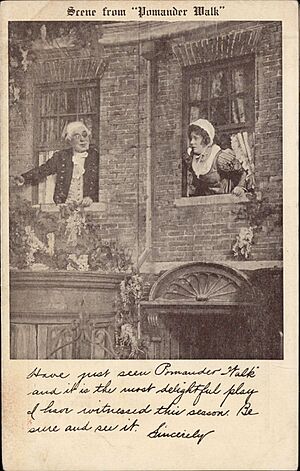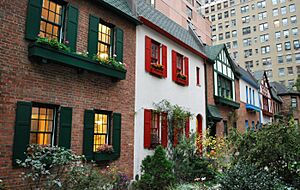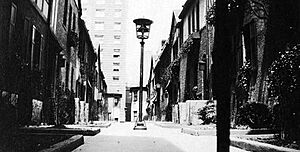Pomander Walk facts for kids
|
Pomander Walk
|
|

Pomander Walk, facing north. The Columbia (275 West 96th Street) is visible in the background
|
|
| Lua error in Module:Location_map at line 420: attempt to index field 'wikibase' (a nil value). | |
| Location |
|
|---|---|
| Built | 1921 |
| Architect | King and Campbell |
| NRHP reference No. | 83001739 |
Quick facts for kids Significant dates |
|
| Added to NRHP | September 14, 1982 |
Pomander Walk is a special group of apartment buildings in Manhattan, New York City. It's located on the Upper West Side, between two big streets called Broadway and West End Avenue. There are 27 buildings in total. Four buildings are on West 94th Street, and seven are on West 95th Street.
The most unique part is the "Walk" itself. It has two rows of eight buildings facing each other. They are separated by a narrow courtyard. There's a locked gate at each end of this courtyard. Each building originally had one apartment on each floor. Today, some have been changed into single-family homes.
Pomander Walk looks very different from the tall buildings around it. It's much smaller and has a unique style. An author named Darryl Pinckney, who used to live there, called it "an insertion of incredible whimsy." This means it's a wonderfully playful and unexpected place. It is a private complex, so you can only visit if you are invited.
Contents
The Story of Pomander Walk
This unique complex gets its name from a romantic comedy play. The play, also called Pomander Walk, opened in New York in 1910. The play was set in an imaginary little street near London. It described five small, old-fashioned houses. These houses looked like miniature Queen Anne mansions.
New York City's Pomander Walk has a Tudoresque style. This style was very popular in America after World War I. It looks a bit like buildings from the Tudor period in England. Even though it's sometimes called a "mews," it's not. A mews is usually a street that used to have stables. Pomander Walk never had stables. The buildings are often described as Storybook Houses. This was a popular building style in the 1920s in both England and the United States.
How Pomander Walk Was Built
Pomander Walk was built in 1921 by a man named Thomas J. Healy. He owned nightclubs and originally wanted to build a big hotel on this spot. However, he couldn't get enough money for the hotel. So, he decided to build these smaller houses instead. He probably planned to tear them down later and build his hotel.
The buildings were designed by the New York architecture firm King and Campbell. But Thomas J. Healy passed away in 1927. Because of this, Pomander Walk stayed just as it was built.
Saving a Special Place
By the 1970s, Pomander Walk was getting old and run-down. There was a risk that it might be torn down. But the people living there worked together to save it. In 1982, it was given special protection. It became a City, State, and National Historic Landmark. This meant it was protected from being destroyed. An earlier attempt to get this protection in 1966 had failed.
In 2009, the owners finished a four-year project. They fixed up the outside of the buildings. They restored many of the original details that had been lost over the years. In 2008, a group called Landmark West! gave Pomander Walk an award for its restoration.
Famous People Who Lived Here
Many interesting people have lived at Pomander Walk over the years. Some of them include:
See also
 In Spanish: Pomander Walk para niños
In Spanish: Pomander Walk para niños




